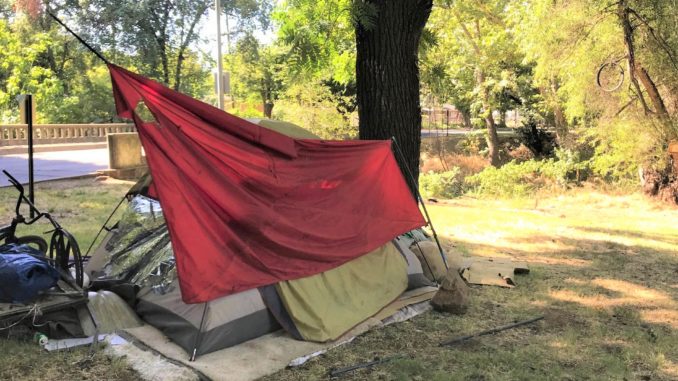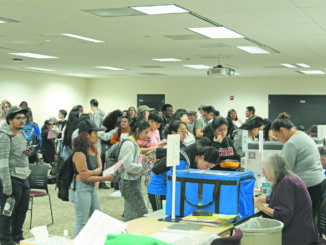
With the exception of mandatory face coverings, arguably the most visible impact of the COVID-19 crisis in Chico is the presence of dozens of long-term encampments in the city’s parks and along its waterways. The camps—which the Chico City Council currently allows in an effort to comply with the U.S. Centers for Disease Control and Prevention’s guidelines to stop the spread of infection among the vulnerable homeless population—have been a focal point of criticism by some citizens since the council ruled to allow them on April 7.
Living at the north end of Orient Street, Sandee Renault says she and her neighbors have been directly and negatively impacted by the presence of campers in the Annie’s Glen section of Bidwell Park, just a stone’s throw from her front porch. In addition to a number of tents in the area, she said people camping in cars flock to the street adjacent to the glen every night.
“There’s always trash, I hear people arguing all the time, and I hear threats of violence,” Renault said. She added that in recent months she’s been chased by aggressive dogs twice and caught someone in the act of stealing cushions from her porch swing in broad daylight. Her biggest fear is that the cooking fires or smokers she’s frequently seen in the camps will spark a blaze in the area’s pervasive dry grass.
Despite these experiences, Renault—a retired physician assistant for Butte County Public Health who, more than a decade ago, spearheaded the successful community effort to install a tunnel to connect Annie’s Glen with the One-Mile Recreation Area—remains sympathetic to the plight of the campers. “I understand the city’s hands are tied, and that you can’t kick people out when they have no place to go,” she said.
A solution that she and several of her neighbors are advocating is for the city to establish a sanctioned campground, an idea that that Chico officials have been exploring as well—though a location and timeline remain unclear.
“A sanctioned campground means people have a safe place to sleep, a safe place to leave their stuff,” Renault said. “It could foster a sense of community and really take care of people, provide services and trash collection and maybe laundry and showers. It would be good for the homeless and good for everyone.”
She and other neighbors have looked at cities where camps are currently operating—such as San Francisco and Portland—and last month began lobbying the City Council, city staff and other public officials to make it happen. “I want to start by saying I share your concerns,” reads an email response she received from Mayor Ann Schwab. “I am devastated about the impacts camping is having on Bidwell Park and our greenways. The position we find ourselves is difficult to manage, at best. It is not how I want the parks to be used.”
The city of Chico has been working toward the goal of a sanctioned campground since launching its COVID response. The week before the City Council essentially de-criminalized park camping, City Manager Mark Orme hired Joy Amaro as Chico’s Homeless Solutions Coordinator, and part of her duties include exploring options for such a facility.
“It’s been a conversation the city has been engaged on for a number of months,” Orme said. “Once the council direction was given to allow encampments in the park, we knew it was not sustainable, that the degradation of the natural resources of the park would be impacted so greatly that staff needed to help develop a plan to eventually find a location for folks to be.
“Candidly, we’ve come a long way on that,” he continued. “We don’t have a final comment as to where that’s going to be and what it’s going to look like, but we’re in conversations and hope to have something sooner than later.”
However, “sooner than later” is not likely fast enough to appease Renault, who wondered why other cities were able to open camps during the first weeks of shutdown and Chico hasn’t been successful now four months into the crisis.
When asked for a more specific timeline, Orme resonded: “We’re hoping it happens this year rather than a year or two down the road.”
He was reticent to provide many details of current plans, but said the city is talking to county representatives about collaborating on the project, and looking at several possible properties—both city-owned and some available for purchase. He also refused to discuss specific locations that are being considered.
Orme acknowledged that, wherever the location may be, it’s likely to inspire some heated community discussion. Vocal opposition stalled two recent efforts to establish permanent locations for shelters. In 2019, Simplicity Village, Chico Housing Action Team’s tiny-house community project that would have housed up to 46 homeless seniors, was waylaid by legal complaints from the site’s neighbors; and earlier that year, discussion about a shelter on Orange Street was quickly stifled by naysayers opposed to its proximity to neighborhoods and Chico State.
“[Opposition] is always a concern,” Orme said. “I think everyone will say homelessness is a problem, but there’s two sides to that argument, the more compassionate side and the ‘lets have more stringent enforcement’ side. Regardless of what side people are on, this is going to be controversial.
“Most people want solutions, but it’s hard to agree on where.”
Nobody on either side of that fence would likely argue that encampments are the best solution. However, volunteers who provide service to the camps and some residents of the camps themselves say their presence thus far has been useful in delivering basic services during a health pandemic.
The main direct cost to the city is providing a half-dozen portable toilets and hand-washing stations near the greatest concentrations of encampments. Regular trash pick-up is carried out by volunteers. Until mid-June, meals prepared by Chico Unified School District and paid for by a grant from United Way of Northern California were delivered daily. That funding ran out, as did another grant that paid case workers from Safe Space to visit the encampments. Some case work and meal delivery continues today on an entirely volunteer basis

Matt Reed, interim executive director of True North Housing Alliance, couldn’t provide specific numbers about the effects of COVID-19 among the local unhoused, but said, “Like all sections of society, this population has been impacted.” He said that sheltering-in-place at encampments, and in hotel rooms provided by Project Roomkey, has undoubtedly had a positive effect in slowing the spread.
Sawyere Lamontagne, a Chico State social work major, has been helping in the encampments since they were established, and now helps coordinate volunteer efforts. The CN&R accompanied him in late June to deliver corn dogs and burritos made by volunteers—as well as cold water provided by the Jesus Center on as day when temperatures had passed 90 by late morning—to encampments along Comanche Creek Greenway.
Lamontagne has developed a rapport with the campers, and he greeted many by first name as he exchanged pleasantries and checked on their needs. He told one man he’d acquired a donated tent for him, and left extra bottles of water outside of a lean-to tucked among the shrubs and oak trees (“The dog who lives here just had a litter of eight puppies, so I bet she needs them,” he explained).
At one camp, Lamontagne stopped to speak with Steve Lambach, a Camp Fire survivor from Paradise still living on the streets of Chico. Lambach said the ability to stay put has helped him make progress toward a better life.
“I have a case worker now and am working through things,” he said. “One of the hardest things about being homeless is having ‘the man’ chase you around all the time, having to gather what you can and run every time we see the police or sheriffs. Where are we supposed to go? We have to be somewhere.”
A possible sanctioned campground location that seems obvious to many—and one proposed by Renault and her neighbors—is the Silver Dollar Fairgrounds, which hosted Camp Fire survivors in the months following the fire. But that’s not likely, according to Amaro.
“The fairgrounds option has been explored in the past at different times, but it’s not really possible,” Amaro said. “As it’s state property, it’s a huge undertaking and there are some major expenses involved. The biggest cost is for security, and the options are either paying CHP or hiring a tremendous amount of private security that make it not feasible, financially.”
City Manager Orme said, though encampments are currently allowed, the City Council direction is “implicitly clear” that they must be located at least 50 feet from waterways. As several camps were not in compliance, the Chico Police Department’s Target Team visited them last week to issue 48-hour notices to move the camps farther away from the creeks.
Also last week, on Thursday (July 9), Renault’s fear of fire hit home when flames scorched an oak tree and a 20-by-20-foot patch of dry grass south of the bike path running through Annie’s Glen, just yards behind a neighbor’s house on East Third Street.
Chico Fire Department Deputy Chief Chris Zinko said the fire started some distance from the encampments and there was no evidence to suggest it was started by campers. He also said there haven’t been any significant fires associated with the encampments to date, but that their presence is some cause for concern.
“Obviously if you have people allowed to stay in those areas, and especially if they’re using camp or cooking fires,” Zinko said, “then you have the increased possibility of fire.”
Amaro, who is also working with local service agencies to establish an emergency shelter in the former Employment Development Department building on Carmichael Drive, said she’s dedicated to the task of establishing a sanctioned campground, but stressed that such facilities are not ideal: “As far as best practices for providing shelter to the unhoused, sanctioned campgrounds aren’t usually included as a recommended part of the continuum and how we care for people.”
Calling these campgrounds “a stop-gap,” she explained how “they’re usually used as a holding spot for people who might be moving from living outside into a more secure place to stay like an emergency shelter,” she said. “We’re looking in that direction now because we’re being reactive to the pandemic, trying to meet CDC guidelines and to appropriately meet people’s needs during this emergency. But it’s not really part of a long-term strategy.”




Be the first to comment